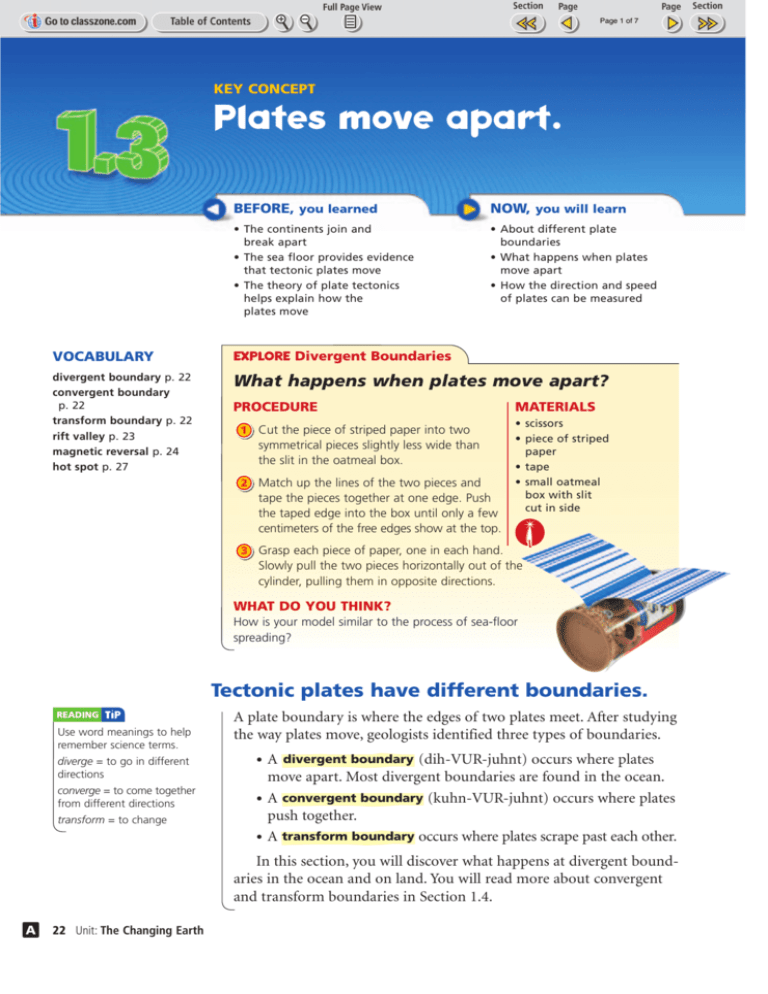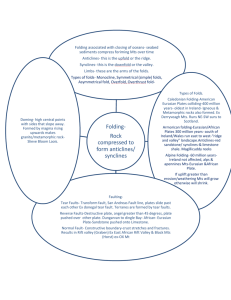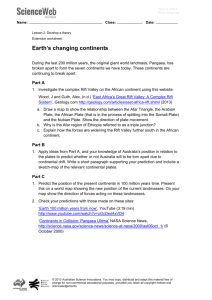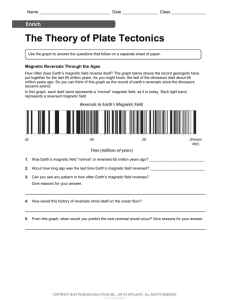What happens when plates move apart?
advertisement

Page 1 of 7 KEY CONCEPT Plates move apart. BEFORE, you learned NOW, you will learn • The continents join and break apart • The sea floor provides evidence that tectonic plates move • The theory of plate tectonics helps explain how the plates move • About different plate boundaries • What happens when plates move apart • How the direction and speed of plates can be measured VOCABULARY EXPLORE Divergent Boundaries divergent boundary p. 22 convergent boundary p. 22 transform boundary p. 22 rift valley p. 23 magnetic reversal p. 24 hot spot p. 27 What happens when plates move apart? PROCEDURE 1 Cut the piece of striped paper into two symmetrical pieces slightly less wide than the slit in the oatmeal box. 2 Match up the lines of the two pieces and tape the pieces together at one edge. Push the taped edge into the box until only a few centimeters of the free edges show at the top. MATERIALS • scissors • piece of striped paper • tape • small oatmeal box with slit cut in side 3 Grasp each piece of paper, one in each hand. Slowly pull the two pieces horizontally out of the cylinder, pulling them in opposite directions. WHAT DO YOU THINK? How is your model similar to the process of sea-floor spreading? Tectonic plates have different boundaries. reading tip Use word meanings to help remember science terms. diverge = to go in different directions converge = to come together from different directions A plate boundary is where the edges of two plates meet. After studying the way plates move, geologists identified three types of boundaries. • • transform = to change • A divergent boundary (dih-VUR-juhnt) occurs where plates move apart. Most divergent boundaries are found in the ocean. A convergent boundary (kuhn-VUR-juhnt) occurs where plates push together. A transform boundary occurs where plates scrape past each other. In this section, you will discover what happens at divergent boundaries in the ocean and on land. You will read more about convergent and transform boundaries in Section 1.4. A B 22 Unit: The Changing Earth Page 2 of 7 The sea floor spreads apart at divergent boundaries. In the ocean, divergent boundaries are also called spreading centers. Mid-ocean ridges mark these sites where the ocean floor is spreading apart. As the ridges continue to widen, a gap called a rift valley forms. Here molten material rises to build new crust. Mid-Ocean Ridges and Rift Valleys Mid-ocean ridges are the longest chain of mountains on Earth. Most of these ridges contain a rift valley along their center, as shown in the diagram below. When molten material rises from the asthenosphere, cold ocean water cools the rock until it becomes solid. As the plates move apart, new cracks open in the solid rock. More molten material rises and hardens. The growing ridge stands high above the sea floor. The world’s longest ridge, the Mid-Atlantic Ridge, runs the length of the Atlantic Ocean. Here the North and South American plates are moving away from the Eurasian and African plates. The ridge extends nearly 11,000 kilometers (6214 mi) from Iceland to near Antarctica. The rift valley is 24 kilometers (15 mi) wide and 9 kilometers (6 mi) deep—about 7 kilometers (4 mi) deeper than the Grand Canyon! Divergent Boundary in the Ocean Mid Atlantic Ridge Mid-ocean ridges, rift valleys, and new crust mark where the sea floor spreads apart. mid-ocean ridge rift valley magma What happens to the old crust as new crust forms? lithosphere asthenosphere Chapter 1: Plate Tectonics 23 A B Page 3 of 7 Sea-Floor Rock and Magnetic Reversals You read earlier that the sea floor is younger near a mid-ocean ridge and older farther away. As scientists continued to study the sea-floor rock, they made a surprising discovery about Earth’s magnetic field. To understand Earth’s magnetic field, you can compare the planet to a bar magnet, which has a north and a south pole. Earth’s magnetic field affects the entire planet, as shown in the diagram below. Notice that Earth’s geographic and magnetic poles are not in the same place. magnetic north pole geographic north pole Red lines show Earth’s magnetic field. Unlike a bar magnet, however, Earth’s magnetic poles switch places every so often. The north pole becomes the south pole and the south pole becomes the north pole. This switch in direction is called a magnetic reversal. Such reversals are caused by changes in Earth’s magnetic field. As yet, no one knows why these changes happen. In contrast, Earth’s geographic poles never change places. Magnetic Reversals Rocks moving away from a mid-ocean ridge carry records of magnetic reversals. mid-ocean ridge normal magnetic field rocks formed when magnetic field reversed A B 24 Unit: The Changing Earth magma rocks formed when magnetic field was normal reversed magnetic field Page 4 of 7 Scientists found that each magnetic reversal is recorded in the sea-floor rock. These records are especially clear at some mid-ocean ridges. As the molten material rises and cools, some magnetic minerals line up with the Earth’s magnetic field. When the material hardens, these minerals are permanently fixed like tiny compass needles pointing north and south. Whenever the magnetic field reverses, the cooling minerals record the change. As shown in the diagram on page 24, the records of magnetic reversals line up like stripes in the rock. As the two plates move away from a mid-ocean ridge, each plate carries a record of magnetic reversals with it. The records are the same on either side of the ridge. As scientists continued to map the ocean floor, they found more records of these reversals. By dating the rock, scientists had further evidence of plate movement. The youngest rock records the most recent reversal, which happened only about 760,000 years ago. The oldest rock, farthest from the mid-ocean ridge, records reversals that happened more than 150 million years ago. Check Your Reading Explain how records of magnetic reversals show that plates move apart. Magnetic Reversals How can you map magnetic reversals? SKILL FOCUS Modeling PROCEDURE 1 Wrap one end of the string around the middle of the bar magnet. Tape the string in place as shown. 2 Place a small piece of tape on one end of the magnet. Label the tape “N” to represent north. 3 Hold the bar magnet over one end of the sea-floor model as shown. Move the magnet SLOWLY toward the other end of the sea-floor model. Record your observations. MATERIALS • • • • • string bar magnet masking tape marking pen sea-floor model TIME 20 minutes WHAT DO YOU THINK? • What did the magnet reveal about the sea-floor model? Draw a diagram showing any pattern that you might have observed. • Which part of the model represents the youngest sea floor? Which part represents the oldest sea floor? CHALLENGE If Earth’s magnetic field had never reversed in the past, how would the sea-floor model be different? Chapter 1: Plate Tectonics 25 A B Page 5 of 7 Continents split apart at divergent boundaries. SUPPORTING MAIN IDEAS Use this diagram to help you take notes on how continents split apart. Like the sea floor, continents also spread apart at a divergent boundary. The boundary begins to form when hot material rises from deep in the mantle. This heat causes the crust to bulge upward. The crust cracks as it is stretched, and a rift valley forms, as shown in the diagram below. Magma rises through the cracked, thinned crust, forming volcanoes. As the rift valley grows wider, the continent begins to split apart. If the rift valley continues to widen, the thinned valley floor sinks lower and lower until it is below sea level. Water from nearby oceans or rivers may fill the valley and form a sea or a lake. In the Middle East, for example, the Arabian Plate and African Plate have been moving apart for several million years. Over time, the waters of the Indian Ocean gradually filled the rift valley, forming the Red Sea. This sea is slowly getting wider as the plates continue to move apart. Check Your Reading What happens when the floor of a rift valley sinks below sea level? Divergent Boundary on Land As rift valleys widen, continents begin to split apart. As the rift widens, the valley floor thins and sinks. rift valley continental crust Rift Valley Widens continental crust Valley Fills With Water The valley floor falls below sea level, which allows water to enter. magma A B 26 Unit: The Changing Earth Page 6 of 7 Great Rift Valley The Great Rift Valley in eastern Africa, shown in the photograph above, is a good example of a continental rift valley. It is getting wider as the African Plate splits apart. This huge valley is thousands of kilometers long and as much as 1800 meters (5900 ft) deep. PREDICT Rift valleys, like the Great Rift Valley in Africa, occur where plates are moving apart. What will happen to the Rift Valley when it gets low enough? Hot spots can be used to track plate movements. In some places, called hot spots, heated rock rises in plumes, or thin columns, from the mantle. Volcanoes often develop above the plume. Although most hot spots occur far from plate boundaries, they offer a way to measure plate movement. This is because a hot spot generally stays in one place while the tectonic plate above it keeps moving. At a hot spot, the heat from the plume partly melts some of the rock in the tectonic plate above it. It is like holding a candle under a wax tablet. Eventually, the wax above the flame will melt. Likewise, if the plate stays over the hot spot long enough, the rock above it will melt. In time, a volcano will form at the surface of the plate. The volcano may become high enough to rise above the sea as an island. For example, the Hawaiian Islands are being built as the Pacific Plate moves slowly over a hot spot. The Hawaiian islands are located in the middle of the Pacific Plate. The largest island, Hawaii, is still over the hot spot. Chapter 1: Plate Tectonics 27 A B Page 7 of 7 Hot Spots Tectonic plates move over hot spots in the mantle. Oceanic Hot Spot Continental Hot Spot mya = million years ago 0 0 100 IDAHO 200 miles 1.3 mya 6.5–4.3 mya 2 mya 100 200 kilometers WYOMING 10.5–8.6 mya 15–13 mya 16.5–15 mya The Pacific Plate carries each Hawaiian island away from the hot spot. Eventually, a new volcano forms over the plume. Hot Spot 10–7 mya 12–10.5 mya N W E S The North American Plate moves southwest, carrying each inactive volcano away from the Yellowstone hot spot. Which island or landform in each diagram was formed first? How do you know? When the plate moves on, it carries the first volcano away from the hot spot. Heat from the mantle plume will then melt the rock at a new site, forming a new volcano. The diagram on the left shows this process. Many hot spots provide a fixed point that scientists can use to measure the speed and direction of plate movements. For example, the Yellowstone hot spot under the North American Plate has formed a chain of inactive volcanoes, as shown in the diagram on the right. Scientists estimate that the North American Plate is moving southwest at about 2.3 cm (1 in.) per year. Check your reading KEY CONCEPTS CRITICAL THINKING 1. Name and describe the three types of plate movements. 4. Predict Suppose a magnetic reversal occurred today. How would new rocks at mid-ocean ridges differ from rocks that formed last year? 2. Create a two-column chart with the headings: Divergent boundary; Features. Fill in the chart for divergent boundaries at sea and on land. 3. How are hot spots used to track plate motion? A B How does a hot-spot volcano form? 28 Unit: The Changing Earth 5. Infer A huge crack runs through Iceland, an island that lies above the Mid-Ocean Ridge. What do you think is happening to this country? CHALLENGE 6. Hypothesize Look carefully at the diagram above and the Hawaiian Islands picture on page 27. Notice that some hot spot islands or landforms are larger than other islands or landforms in the same chain. Develop a hypothesis, based on plate movement, that might explain this fact.








